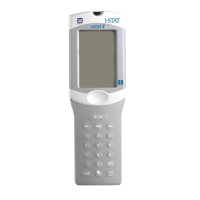Rev. Date: 03-Aug-12 Art: 714177-00N Glu - 3
Precision Data (mg/dL)
Aqueous Control Mean SD %CV
Level 1 41.8 0.68 1.6
Level 3 289 2.4 0.8
Method Comparison (mg/dL)
Beckman Coulter
LX20
Bayer 860 Dade Dimension
RxL-Xpand
n 35 40 32
Sxx 2.21 4.71 0.98
Syy 0.69 0.96 0.59
Slope 1.03 0.99 1.01
Int’t -3.39 -1.67 -0.85
Sy.x 0.91 0.70 1.57
Xmin 45 58 48
Xmax 297 167 257
r 0.999 0.993 0.998
Cartridge Comparison
The performance characteristics of the sensors are equivalent in all cartridge configurations. System
difference analysis was performed on 34 patient samples using the i-STAT CHEM8+ and i-STAT CG8+
cartridges. In the 65–249 mg/dL range, the average difference was 0.80.
Factors Affecting Results*
Glucose values will decrease in whole blood samples over time. Venous blood glucose is as much as
7 mg/dL less than capillary blood glucose as a result of tissue utilization.
6
Test concentrations used were as per the CLSI guidance document,
7
unless otherwise indicated.
The following substances are known to interfere with the i-STAT glucose assay:
Substance
Test Concentration
(mmol/L)
Interference
Acetaminophen 1.32
Increased i-STAT Glucose results. See
Note Below
Acetylcysteine 10.2
Decreased i-STAT Glucose results. See
Note below.
Bromide 37.5
Decreased i-STAT Glucose results. See
Note below.
Bromide (therapeutic) 2.5
8,9,10
Decreased i-STAT Glucose results by
approximately 5 mg/dL. See Note below.
Hydroxyurea 0.92
Increased i-STAT Glucose results. Use
another method.
Thiocyanate 6.9
Decreased i-STAT Glucose results by
approximately 7 mg/dL.
The following substances are known not to significantly interfere with the i-STAT glucose assay at
the stated test concentrations:
Substance
Test Concentration
(mmol/L)
Acetaldehyde 0.045
11
Acetaminophen (therapeutic) 0.132
11
Acetoacetate 2.0
Acetylcysteine (therapeutic) 0.3
12,13
Ascorbate 0.34
Dopamine 0.006
Formaldehyde 0.133
11

